The Australian Mining Industry: Market Conditions, Changes and Impacts
VerifiedAdded on 2022/08/22
|13
|2961
|28
Report
AI Summary
This report provides an analysis of the Australian mining industry, examining its historical growth, market description, and key players. It highlights Australia's comparative advantage in mineral production, driven by abundant natural resources and efficient production techniques. The report explores the impact of market changes, such as fluctuating export demand from countries like China and South Korea, and the adoption of innovative technologies. It discusses the role of government policies, including tax credits and environmental regulations, and their influence on production costs and market dynamics. The analysis also addresses the challenges posed by declining export demand and the restructuring of the coal sector in major trading partners, impacting the industry's economic profits and overall growth. The report concludes by summarizing how market conditions and changes have affected the mining sector.
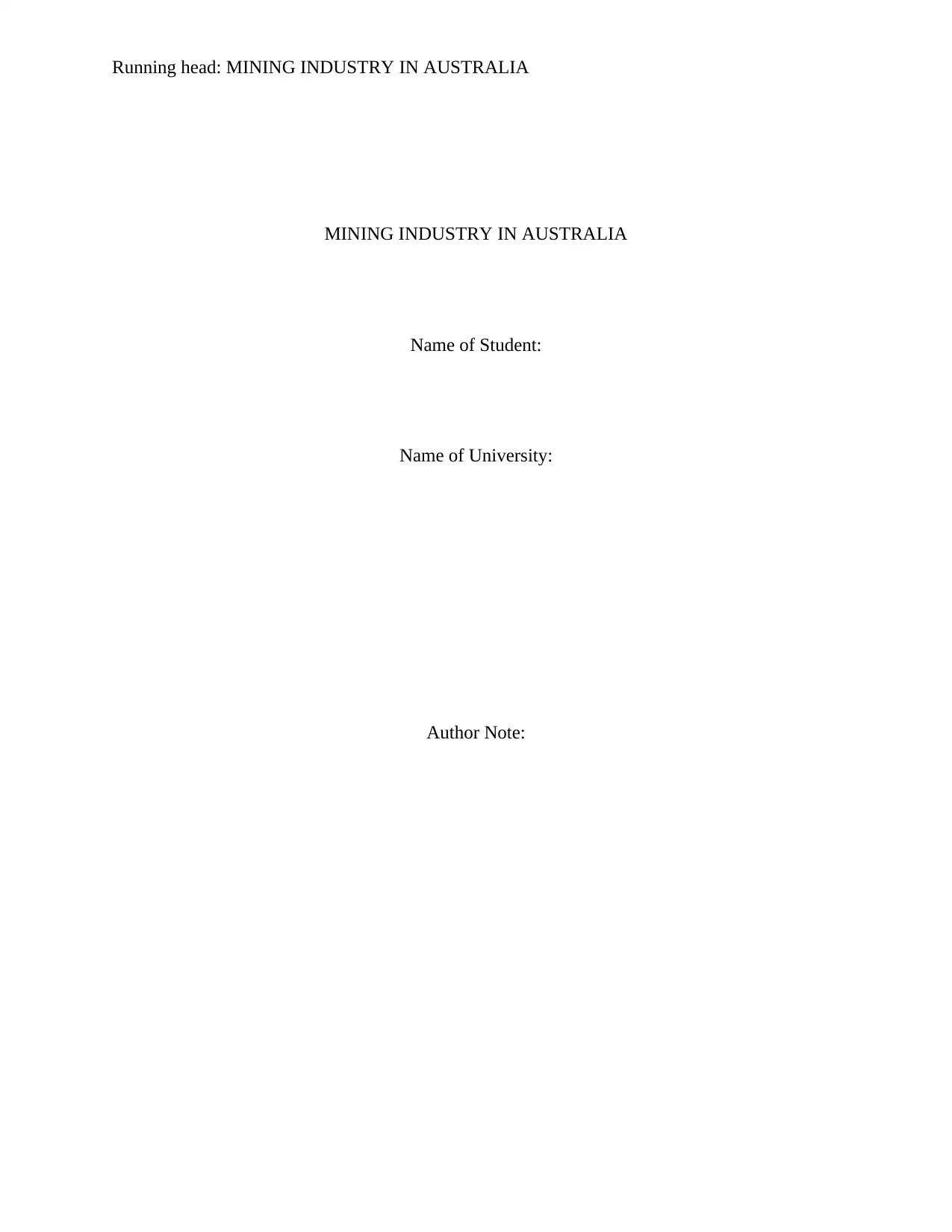
Running head: MINING INDUSTRY IN AUSTRALIA
MINING INDUSTRY IN AUSTRALIA
Name of Student:
Name of University:
Author Note:
MINING INDUSTRY IN AUSTRALIA
Name of Student:
Name of University:
Author Note:
Paraphrase This Document
Need a fresh take? Get an instant paraphrase of this document with our AI Paraphraser
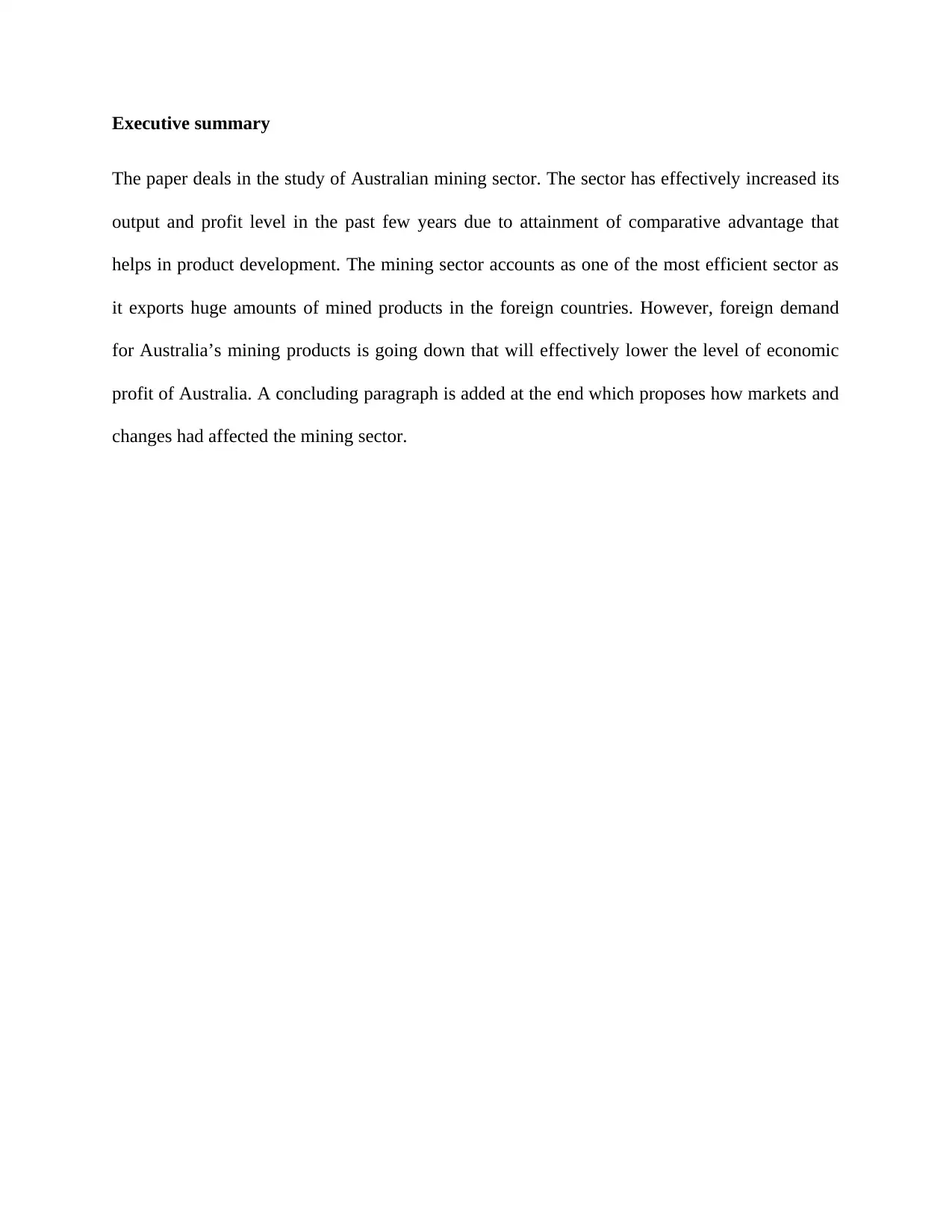
Executive summary
The paper deals in the study of Australian mining sector. The sector has effectively increased its
output and profit level in the past few years due to attainment of comparative advantage that
helps in product development. The mining sector accounts as one of the most efficient sector as
it exports huge amounts of mined products in the foreign countries. However, foreign demand
for Australia’s mining products is going down that will effectively lower the level of economic
profit of Australia. A concluding paragraph is added at the end which proposes how markets and
changes had affected the mining sector.
The paper deals in the study of Australian mining sector. The sector has effectively increased its
output and profit level in the past few years due to attainment of comparative advantage that
helps in product development. The mining sector accounts as one of the most efficient sector as
it exports huge amounts of mined products in the foreign countries. However, foreign demand
for Australia’s mining products is going down that will effectively lower the level of economic
profit of Australia. A concluding paragraph is added at the end which proposes how markets and
changes had affected the mining sector.
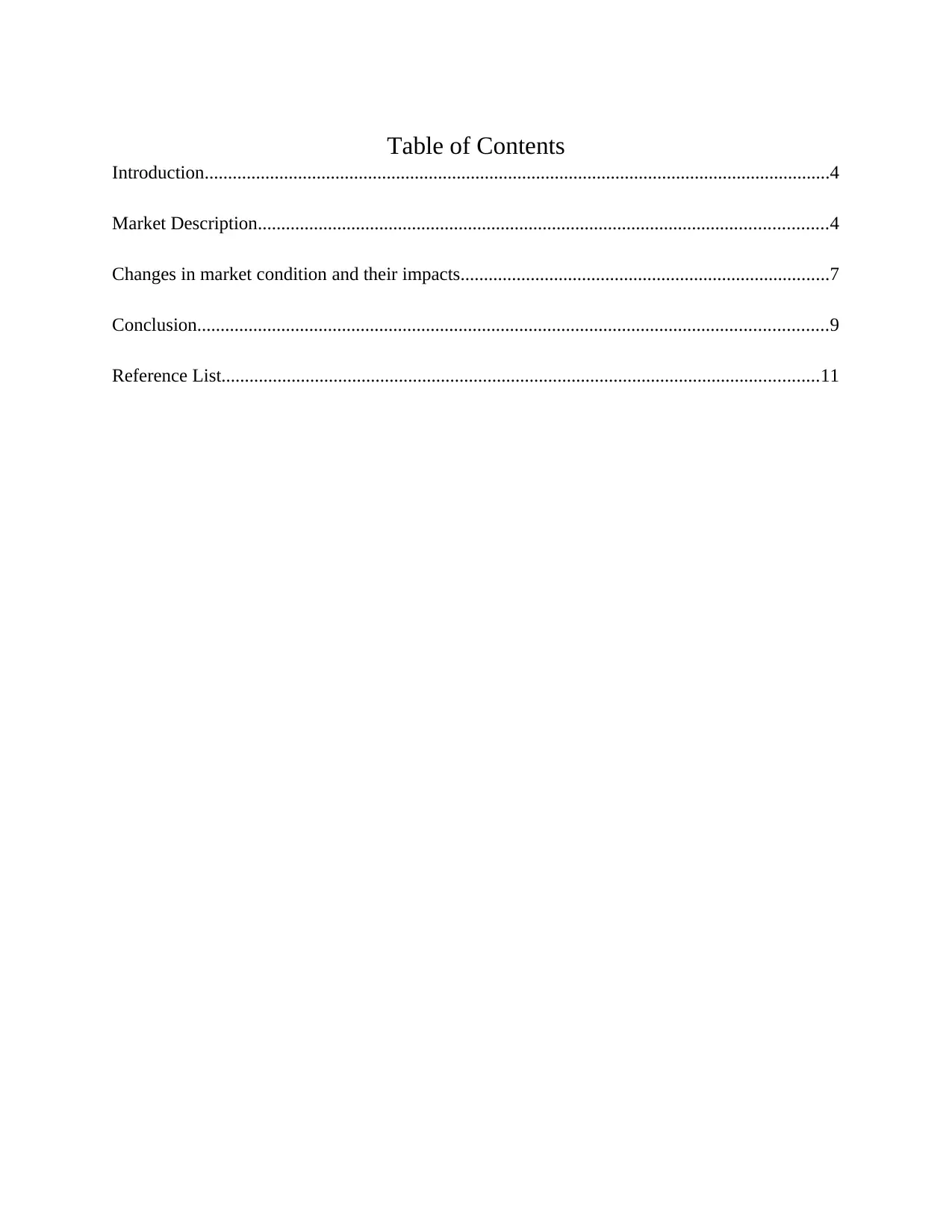
Table of Contents
Introduction......................................................................................................................................4
Market Description..........................................................................................................................4
Changes in market condition and their impacts...............................................................................7
Conclusion.......................................................................................................................................9
Reference List................................................................................................................................11
Introduction......................................................................................................................................4
Market Description..........................................................................................................................4
Changes in market condition and their impacts...............................................................................7
Conclusion.......................................................................................................................................9
Reference List................................................................................................................................11
⊘ This is a preview!⊘
Do you want full access?
Subscribe today to unlock all pages.

Trusted by 1+ million students worldwide
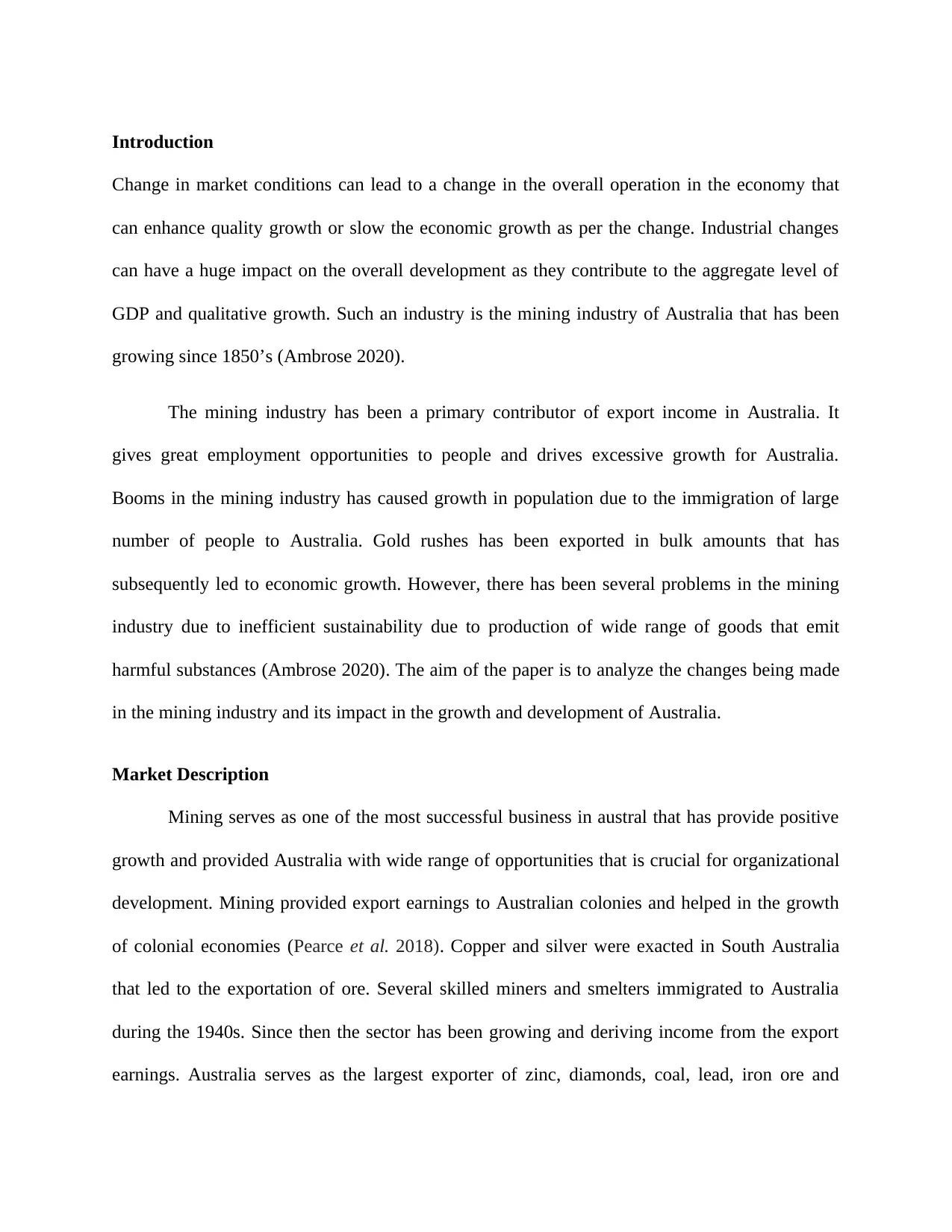
Introduction
Change in market conditions can lead to a change in the overall operation in the economy that
can enhance quality growth or slow the economic growth as per the change. Industrial changes
can have a huge impact on the overall development as they contribute to the aggregate level of
GDP and qualitative growth. Such an industry is the mining industry of Australia that has been
growing since 1850’s (Ambrose 2020).
The mining industry has been a primary contributor of export income in Australia. It
gives great employment opportunities to people and drives excessive growth for Australia.
Booms in the mining industry has caused growth in population due to the immigration of large
number of people to Australia. Gold rushes has been exported in bulk amounts that has
subsequently led to economic growth. However, there has been several problems in the mining
industry due to inefficient sustainability due to production of wide range of goods that emit
harmful substances (Ambrose 2020). The aim of the paper is to analyze the changes being made
in the mining industry and its impact in the growth and development of Australia.
Market Description
Mining serves as one of the most successful business in austral that has provide positive
growth and provided Australia with wide range of opportunities that is crucial for organizational
development. Mining provided export earnings to Australian colonies and helped in the growth
of colonial economies (Pearce et al. 2018). Copper and silver were exacted in South Australia
that led to the exportation of ore. Several skilled miners and smelters immigrated to Australia
during the 1940s. Since then the sector has been growing and deriving income from the export
earnings. Australia serves as the largest exporter of zinc, diamonds, coal, lead, iron ore and
Change in market conditions can lead to a change in the overall operation in the economy that
can enhance quality growth or slow the economic growth as per the change. Industrial changes
can have a huge impact on the overall development as they contribute to the aggregate level of
GDP and qualitative growth. Such an industry is the mining industry of Australia that has been
growing since 1850’s (Ambrose 2020).
The mining industry has been a primary contributor of export income in Australia. It
gives great employment opportunities to people and drives excessive growth for Australia.
Booms in the mining industry has caused growth in population due to the immigration of large
number of people to Australia. Gold rushes has been exported in bulk amounts that has
subsequently led to economic growth. However, there has been several problems in the mining
industry due to inefficient sustainability due to production of wide range of goods that emit
harmful substances (Ambrose 2020). The aim of the paper is to analyze the changes being made
in the mining industry and its impact in the growth and development of Australia.
Market Description
Mining serves as one of the most successful business in austral that has provide positive
growth and provided Australia with wide range of opportunities that is crucial for organizational
development. Mining provided export earnings to Australian colonies and helped in the growth
of colonial economies (Pearce et al. 2018). Copper and silver were exacted in South Australia
that led to the exportation of ore. Several skilled miners and smelters immigrated to Australia
during the 1940s. Since then the sector has been growing and deriving income from the export
earnings. Australia serves as the largest exporter of zinc, diamonds, coal, lead, iron ore and
Paraphrase This Document
Need a fresh take? Get an instant paraphrase of this document with our AI Paraphraser
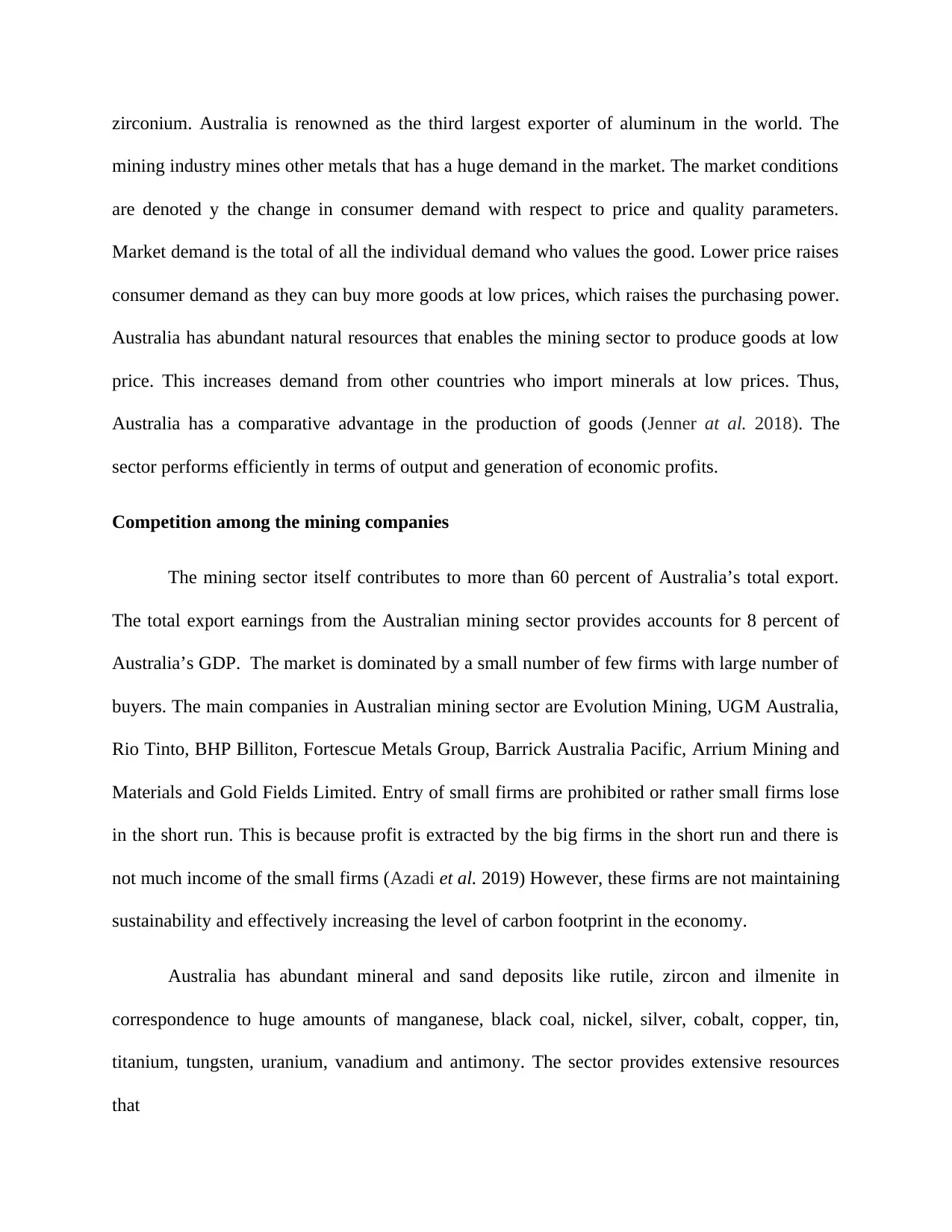
zirconium. Australia is renowned as the third largest exporter of aluminum in the world. The
mining industry mines other metals that has a huge demand in the market. The market conditions
are denoted y the change in consumer demand with respect to price and quality parameters.
Market demand is the total of all the individual demand who values the good. Lower price raises
consumer demand as they can buy more goods at low prices, which raises the purchasing power.
Australia has abundant natural resources that enables the mining sector to produce goods at low
price. This increases demand from other countries who import minerals at low prices. Thus,
Australia has a comparative advantage in the production of goods (Jenner at al. 2018). The
sector performs efficiently in terms of output and generation of economic profits.
Competition among the mining companies
The mining sector itself contributes to more than 60 percent of Australia’s total export.
The total export earnings from the Australian mining sector provides accounts for 8 percent of
Australia’s GDP. The market is dominated by a small number of few firms with large number of
buyers. The main companies in Australian mining sector are Evolution Mining, UGM Australia,
Rio Tinto, BHP Billiton, Fortescue Metals Group, Barrick Australia Pacific, Arrium Mining and
Materials and Gold Fields Limited. Entry of small firms are prohibited or rather small firms lose
in the short run. This is because profit is extracted by the big firms in the short run and there is
not much income of the small firms (Azadi et al. 2019) However, these firms are not maintaining
sustainability and effectively increasing the level of carbon footprint in the economy.
Australia has abundant mineral and sand deposits like rutile, zircon and ilmenite in
correspondence to huge amounts of manganese, black coal, nickel, silver, cobalt, copper, tin,
titanium, tungsten, uranium, vanadium and antimony. The sector provides extensive resources
that
mining industry mines other metals that has a huge demand in the market. The market conditions
are denoted y the change in consumer demand with respect to price and quality parameters.
Market demand is the total of all the individual demand who values the good. Lower price raises
consumer demand as they can buy more goods at low prices, which raises the purchasing power.
Australia has abundant natural resources that enables the mining sector to produce goods at low
price. This increases demand from other countries who import minerals at low prices. Thus,
Australia has a comparative advantage in the production of goods (Jenner at al. 2018). The
sector performs efficiently in terms of output and generation of economic profits.
Competition among the mining companies
The mining sector itself contributes to more than 60 percent of Australia’s total export.
The total export earnings from the Australian mining sector provides accounts for 8 percent of
Australia’s GDP. The market is dominated by a small number of few firms with large number of
buyers. The main companies in Australian mining sector are Evolution Mining, UGM Australia,
Rio Tinto, BHP Billiton, Fortescue Metals Group, Barrick Australia Pacific, Arrium Mining and
Materials and Gold Fields Limited. Entry of small firms are prohibited or rather small firms lose
in the short run. This is because profit is extracted by the big firms in the short run and there is
not much income of the small firms (Azadi et al. 2019) However, these firms are not maintaining
sustainability and effectively increasing the level of carbon footprint in the economy.
Australia has abundant mineral and sand deposits like rutile, zircon and ilmenite in
correspondence to huge amounts of manganese, black coal, nickel, silver, cobalt, copper, tin,
titanium, tungsten, uranium, vanadium and antimony. The sector provides extensive resources
that
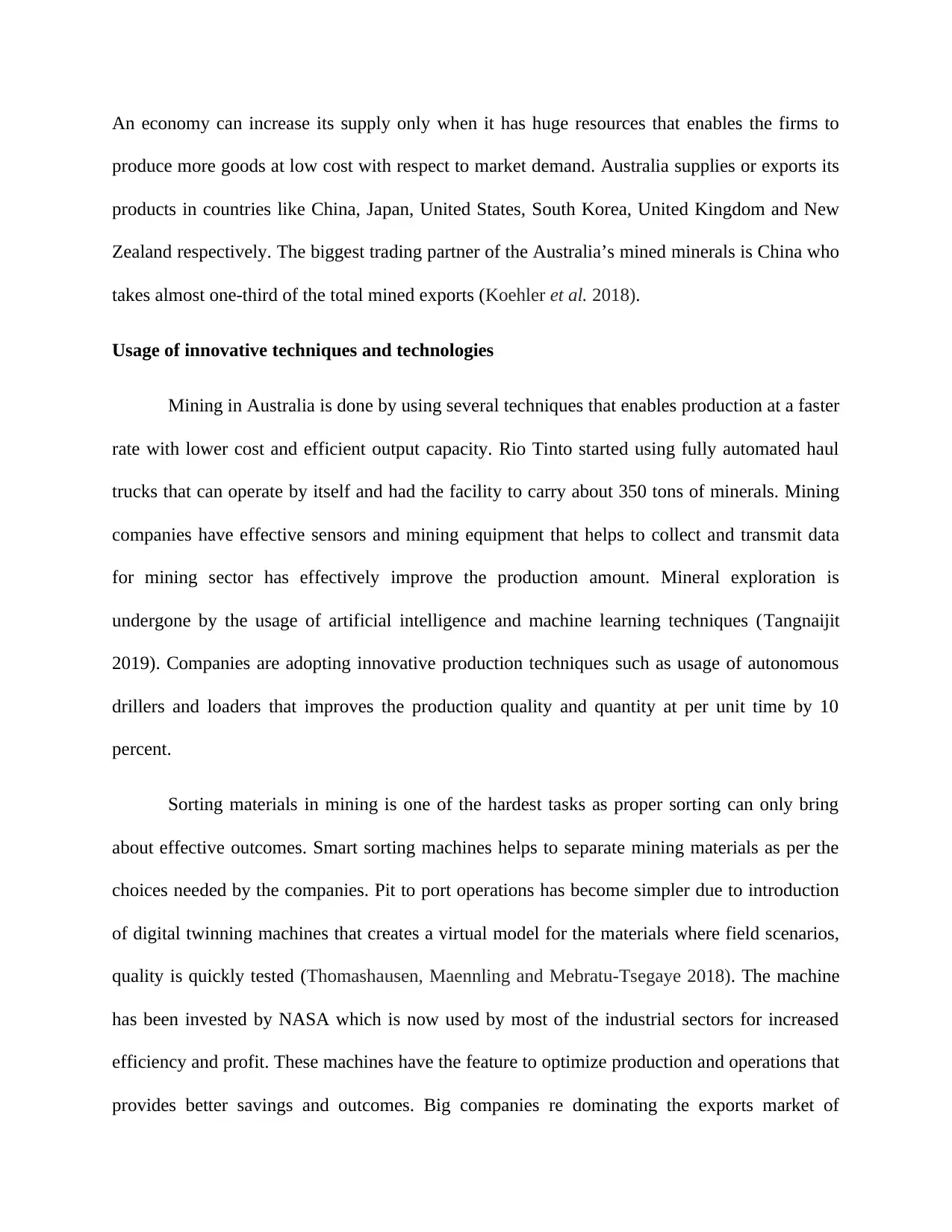
An economy can increase its supply only when it has huge resources that enables the firms to
produce more goods at low cost with respect to market demand. Australia supplies or exports its
products in countries like China, Japan, United States, South Korea, United Kingdom and New
Zealand respectively. The biggest trading partner of the Australia’s mined minerals is China who
takes almost one-third of the total mined exports (Koehler et al. 2018).
Usage of innovative techniques and technologies
Mining in Australia is done by using several techniques that enables production at a faster
rate with lower cost and efficient output capacity. Rio Tinto started using fully automated haul
trucks that can operate by itself and had the facility to carry about 350 tons of minerals. Mining
companies have effective sensors and mining equipment that helps to collect and transmit data
for mining sector has effectively improve the production amount. Mineral exploration is
undergone by the usage of artificial intelligence and machine learning techniques (Tangnaijit
2019). Companies are adopting innovative production techniques such as usage of autonomous
drillers and loaders that improves the production quality and quantity at per unit time by 10
percent.
Sorting materials in mining is one of the hardest tasks as proper sorting can only bring
about effective outcomes. Smart sorting machines helps to separate mining materials as per the
choices needed by the companies. Pit to port operations has become simpler due to introduction
of digital twinning machines that creates a virtual model for the materials where field scenarios,
quality is quickly tested (Thomashausen, Maennling and Mebratu-Tsegaye 2018). The machine
has been invested by NASA which is now used by most of the industrial sectors for increased
efficiency and profit. These machines have the feature to optimize production and operations that
provides better savings and outcomes. Big companies re dominating the exports market of
produce more goods at low cost with respect to market demand. Australia supplies or exports its
products in countries like China, Japan, United States, South Korea, United Kingdom and New
Zealand respectively. The biggest trading partner of the Australia’s mined minerals is China who
takes almost one-third of the total mined exports (Koehler et al. 2018).
Usage of innovative techniques and technologies
Mining in Australia is done by using several techniques that enables production at a faster
rate with lower cost and efficient output capacity. Rio Tinto started using fully automated haul
trucks that can operate by itself and had the facility to carry about 350 tons of minerals. Mining
companies have effective sensors and mining equipment that helps to collect and transmit data
for mining sector has effectively improve the production amount. Mineral exploration is
undergone by the usage of artificial intelligence and machine learning techniques (Tangnaijit
2019). Companies are adopting innovative production techniques such as usage of autonomous
drillers and loaders that improves the production quality and quantity at per unit time by 10
percent.
Sorting materials in mining is one of the hardest tasks as proper sorting can only bring
about effective outcomes. Smart sorting machines helps to separate mining materials as per the
choices needed by the companies. Pit to port operations has become simpler due to introduction
of digital twinning machines that creates a virtual model for the materials where field scenarios,
quality is quickly tested (Thomashausen, Maennling and Mebratu-Tsegaye 2018). The machine
has been invested by NASA which is now used by most of the industrial sectors for increased
efficiency and profit. These machines have the feature to optimize production and operations that
provides better savings and outcomes. Big companies re dominating the exports market of
⊘ This is a preview!⊘
Do you want full access?
Subscribe today to unlock all pages.

Trusted by 1+ million students worldwide
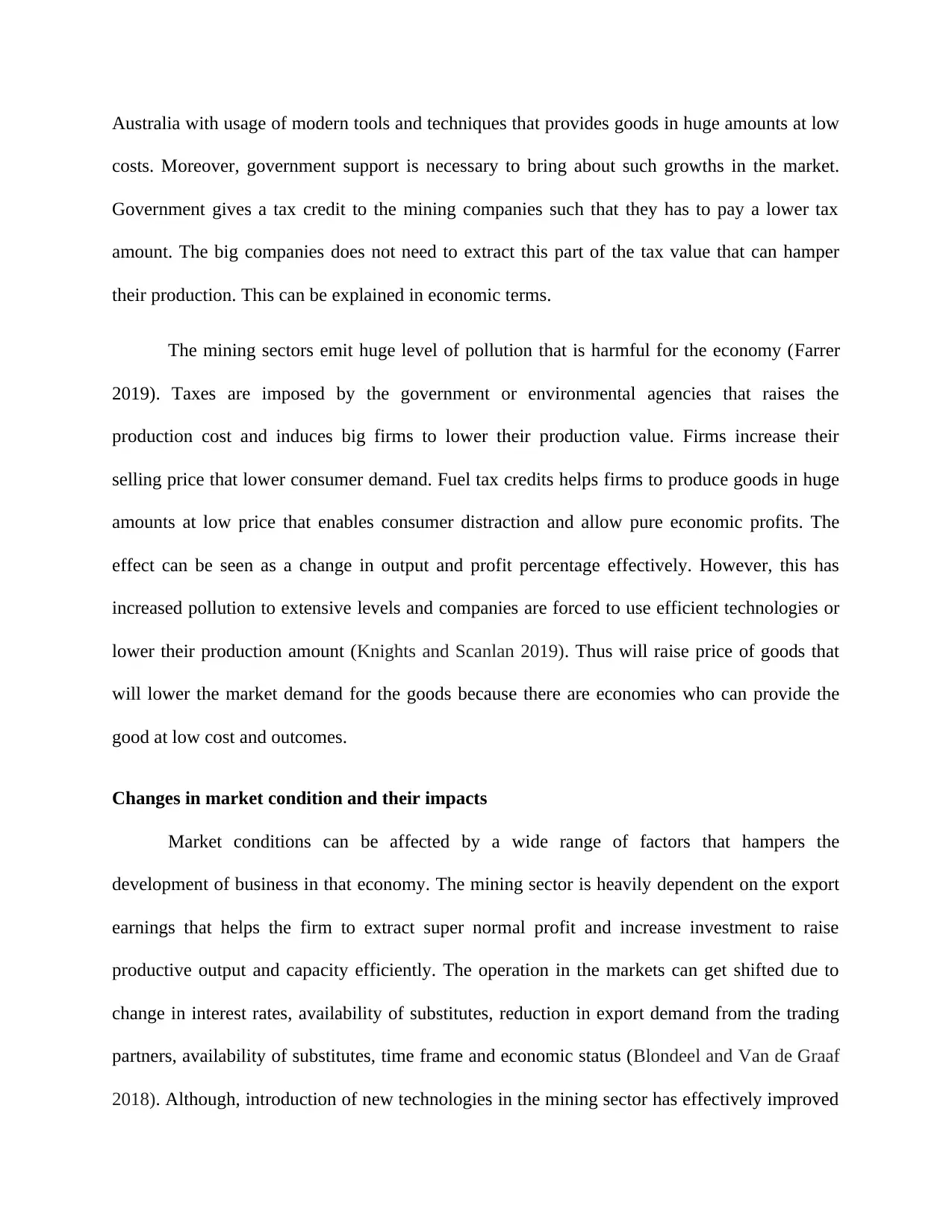
Australia with usage of modern tools and techniques that provides goods in huge amounts at low
costs. Moreover, government support is necessary to bring about such growths in the market.
Government gives a tax credit to the mining companies such that they has to pay a lower tax
amount. The big companies does not need to extract this part of the tax value that can hamper
their production. This can be explained in economic terms.
The mining sectors emit huge level of pollution that is harmful for the economy (Farrer
2019). Taxes are imposed by the government or environmental agencies that raises the
production cost and induces big firms to lower their production value. Firms increase their
selling price that lower consumer demand. Fuel tax credits helps firms to produce goods in huge
amounts at low price that enables consumer distraction and allow pure economic profits. The
effect can be seen as a change in output and profit percentage effectively. However, this has
increased pollution to extensive levels and companies are forced to use efficient technologies or
lower their production amount (Knights and Scanlan 2019). Thus will raise price of goods that
will lower the market demand for the goods because there are economies who can provide the
good at low cost and outcomes.
Changes in market condition and their impacts
Market conditions can be affected by a wide range of factors that hampers the
development of business in that economy. The mining sector is heavily dependent on the export
earnings that helps the firm to extract super normal profit and increase investment to raise
productive output and capacity efficiently. The operation in the markets can get shifted due to
change in interest rates, availability of substitutes, reduction in export demand from the trading
partners, availability of substitutes, time frame and economic status (Blondeel and Van de Graaf
2018). Although, introduction of new technologies in the mining sector has effectively improved
costs. Moreover, government support is necessary to bring about such growths in the market.
Government gives a tax credit to the mining companies such that they has to pay a lower tax
amount. The big companies does not need to extract this part of the tax value that can hamper
their production. This can be explained in economic terms.
The mining sectors emit huge level of pollution that is harmful for the economy (Farrer
2019). Taxes are imposed by the government or environmental agencies that raises the
production cost and induces big firms to lower their production value. Firms increase their
selling price that lower consumer demand. Fuel tax credits helps firms to produce goods in huge
amounts at low price that enables consumer distraction and allow pure economic profits. The
effect can be seen as a change in output and profit percentage effectively. However, this has
increased pollution to extensive levels and companies are forced to use efficient technologies or
lower their production amount (Knights and Scanlan 2019). Thus will raise price of goods that
will lower the market demand for the goods because there are economies who can provide the
good at low cost and outcomes.
Changes in market condition and their impacts
Market conditions can be affected by a wide range of factors that hampers the
development of business in that economy. The mining sector is heavily dependent on the export
earnings that helps the firm to extract super normal profit and increase investment to raise
productive output and capacity efficiently. The operation in the markets can get shifted due to
change in interest rates, availability of substitutes, reduction in export demand from the trading
partners, availability of substitutes, time frame and economic status (Blondeel and Van de Graaf
2018). Although, introduction of new technologies in the mining sector has effectively improved
Paraphrase This Document
Need a fresh take? Get an instant paraphrase of this document with our AI Paraphraser
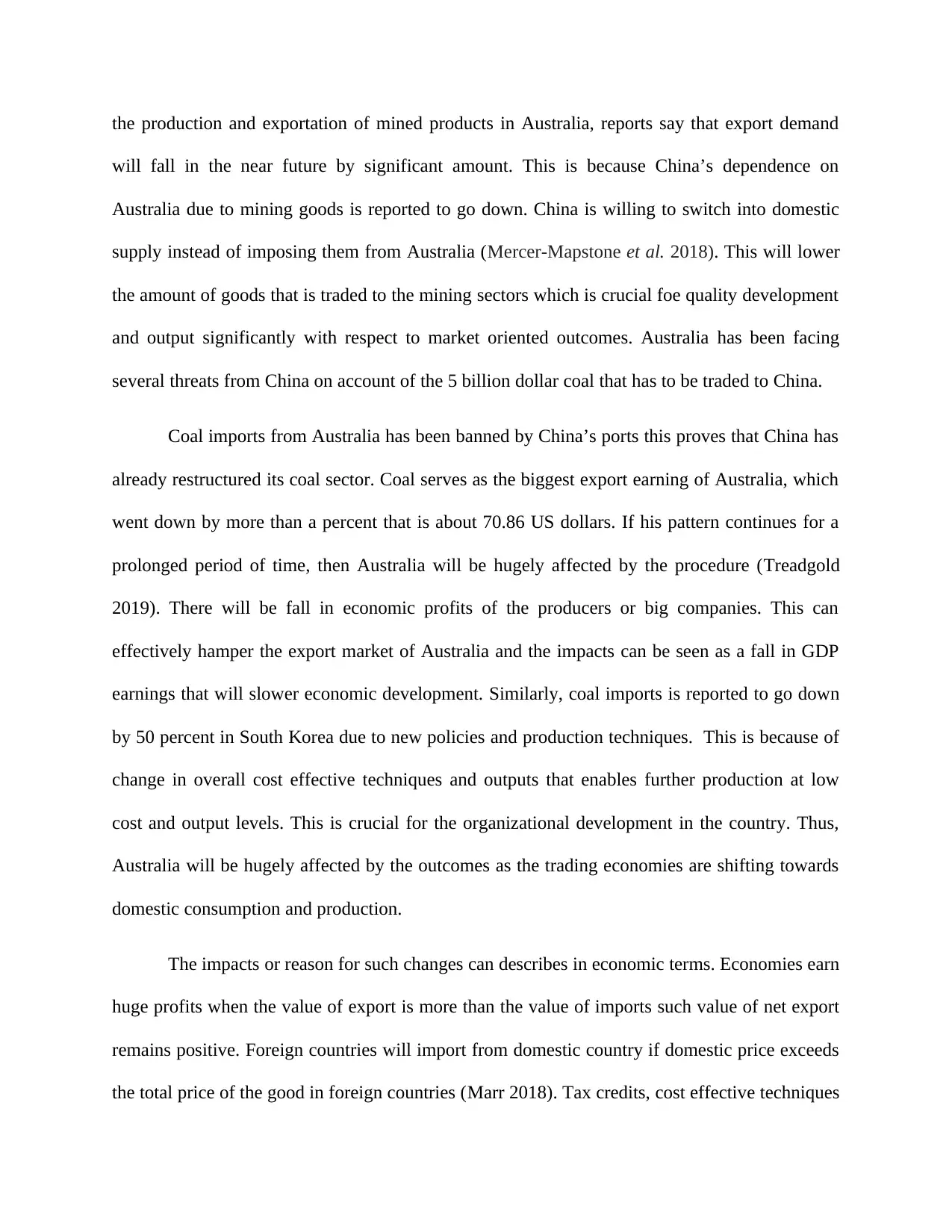
the production and exportation of mined products in Australia, reports say that export demand
will fall in the near future by significant amount. This is because China’s dependence on
Australia due to mining goods is reported to go down. China is willing to switch into domestic
supply instead of imposing them from Australia (Mercer-Mapstone et al. 2018). This will lower
the amount of goods that is traded to the mining sectors which is crucial foe quality development
and output significantly with respect to market oriented outcomes. Australia has been facing
several threats from China on account of the 5 billion dollar coal that has to be traded to China.
Coal imports from Australia has been banned by China’s ports this proves that China has
already restructured its coal sector. Coal serves as the biggest export earning of Australia, which
went down by more than a percent that is about 70.86 US dollars. If his pattern continues for a
prolonged period of time, then Australia will be hugely affected by the procedure (Treadgold
2019). There will be fall in economic profits of the producers or big companies. This can
effectively hamper the export market of Australia and the impacts can be seen as a fall in GDP
earnings that will slower economic development. Similarly, coal imports is reported to go down
by 50 percent in South Korea due to new policies and production techniques. This is because of
change in overall cost effective techniques and outputs that enables further production at low
cost and output levels. This is crucial for the organizational development in the country. Thus,
Australia will be hugely affected by the outcomes as the trading economies are shifting towards
domestic consumption and production.
The impacts or reason for such changes can describes in economic terms. Economies earn
huge profits when the value of export is more than the value of imports such value of net export
remains positive. Foreign countries will import from domestic country if domestic price exceeds
the total price of the good in foreign countries (Marr 2018). Tax credits, cost effective techniques
will fall in the near future by significant amount. This is because China’s dependence on
Australia due to mining goods is reported to go down. China is willing to switch into domestic
supply instead of imposing them from Australia (Mercer-Mapstone et al. 2018). This will lower
the amount of goods that is traded to the mining sectors which is crucial foe quality development
and output significantly with respect to market oriented outcomes. Australia has been facing
several threats from China on account of the 5 billion dollar coal that has to be traded to China.
Coal imports from Australia has been banned by China’s ports this proves that China has
already restructured its coal sector. Coal serves as the biggest export earning of Australia, which
went down by more than a percent that is about 70.86 US dollars. If his pattern continues for a
prolonged period of time, then Australia will be hugely affected by the procedure (Treadgold
2019). There will be fall in economic profits of the producers or big companies. This can
effectively hamper the export market of Australia and the impacts can be seen as a fall in GDP
earnings that will slower economic development. Similarly, coal imports is reported to go down
by 50 percent in South Korea due to new policies and production techniques. This is because of
change in overall cost effective techniques and outputs that enables further production at low
cost and output levels. This is crucial for the organizational development in the country. Thus,
Australia will be hugely affected by the outcomes as the trading economies are shifting towards
domestic consumption and production.
The impacts or reason for such changes can describes in economic terms. Economies earn
huge profits when the value of export is more than the value of imports such value of net export
remains positive. Foreign countries will import from domestic country if domestic price exceeds
the total price of the good in foreign countries (Marr 2018). Tax credits, cost effective techniques
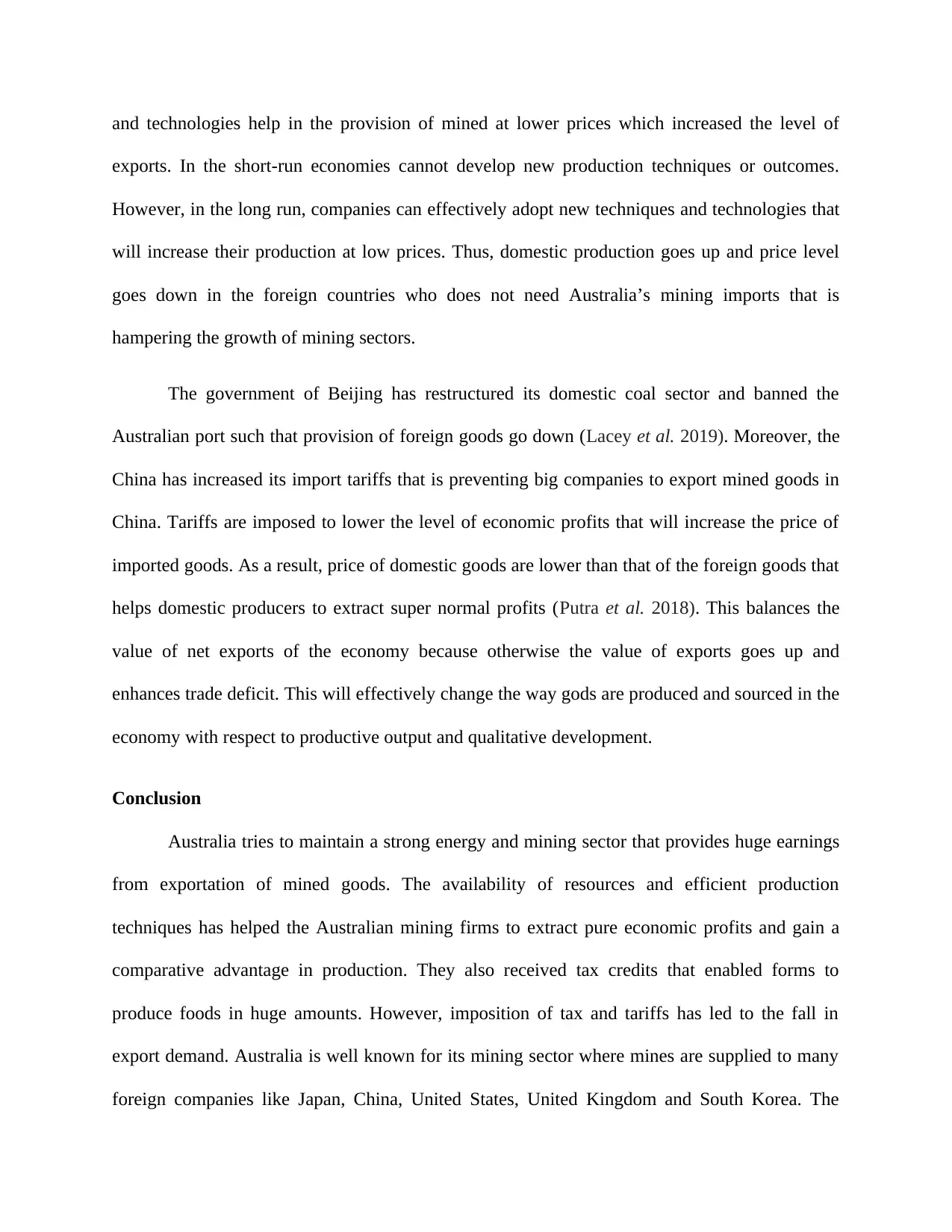
and technologies help in the provision of mined at lower prices which increased the level of
exports. In the short-run economies cannot develop new production techniques or outcomes.
However, in the long run, companies can effectively adopt new techniques and technologies that
will increase their production at low prices. Thus, domestic production goes up and price level
goes down in the foreign countries who does not need Australia’s mining imports that is
hampering the growth of mining sectors.
The government of Beijing has restructured its domestic coal sector and banned the
Australian port such that provision of foreign goods go down (Lacey et al. 2019). Moreover, the
China has increased its import tariffs that is preventing big companies to export mined goods in
China. Tariffs are imposed to lower the level of economic profits that will increase the price of
imported goods. As a result, price of domestic goods are lower than that of the foreign goods that
helps domestic producers to extract super normal profits (Putra et al. 2018). This balances the
value of net exports of the economy because otherwise the value of exports goes up and
enhances trade deficit. This will effectively change the way gods are produced and sourced in the
economy with respect to productive output and qualitative development.
Conclusion
Australia tries to maintain a strong energy and mining sector that provides huge earnings
from exportation of mined goods. The availability of resources and efficient production
techniques has helped the Australian mining firms to extract pure economic profits and gain a
comparative advantage in production. They also received tax credits that enabled forms to
produce foods in huge amounts. However, imposition of tax and tariffs has led to the fall in
export demand. Australia is well known for its mining sector where mines are supplied to many
foreign companies like Japan, China, United States, United Kingdom and South Korea. The
exports. In the short-run economies cannot develop new production techniques or outcomes.
However, in the long run, companies can effectively adopt new techniques and technologies that
will increase their production at low prices. Thus, domestic production goes up and price level
goes down in the foreign countries who does not need Australia’s mining imports that is
hampering the growth of mining sectors.
The government of Beijing has restructured its domestic coal sector and banned the
Australian port such that provision of foreign goods go down (Lacey et al. 2019). Moreover, the
China has increased its import tariffs that is preventing big companies to export mined goods in
China. Tariffs are imposed to lower the level of economic profits that will increase the price of
imported goods. As a result, price of domestic goods are lower than that of the foreign goods that
helps domestic producers to extract super normal profits (Putra et al. 2018). This balances the
value of net exports of the economy because otherwise the value of exports goes up and
enhances trade deficit. This will effectively change the way gods are produced and sourced in the
economy with respect to productive output and qualitative development.
Conclusion
Australia tries to maintain a strong energy and mining sector that provides huge earnings
from exportation of mined goods. The availability of resources and efficient production
techniques has helped the Australian mining firms to extract pure economic profits and gain a
comparative advantage in production. They also received tax credits that enabled forms to
produce foods in huge amounts. However, imposition of tax and tariffs has led to the fall in
export demand. Australia is well known for its mining sector where mines are supplied to many
foreign companies like Japan, China, United States, United Kingdom and South Korea. The
⊘ This is a preview!⊘
Do you want full access?
Subscribe today to unlock all pages.

Trusted by 1+ million students worldwide
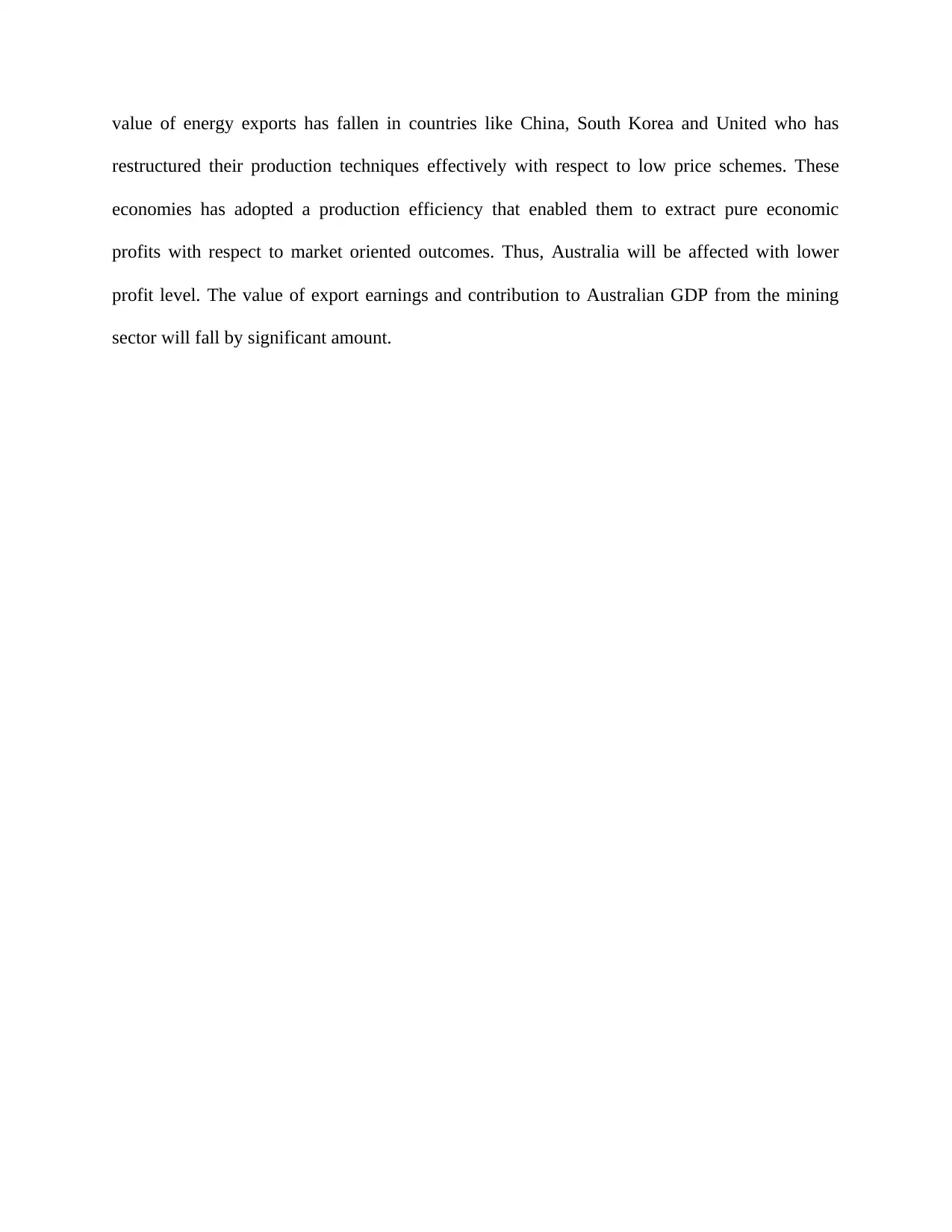
value of energy exports has fallen in countries like China, South Korea and United who has
restructured their production techniques effectively with respect to low price schemes. These
economies has adopted a production efficiency that enabled them to extract pure economic
profits with respect to market oriented outcomes. Thus, Australia will be affected with lower
profit level. The value of export earnings and contribution to Australian GDP from the mining
sector will fall by significant amount.
restructured their production techniques effectively with respect to low price schemes. These
economies has adopted a production efficiency that enabled them to extract pure economic
profits with respect to market oriented outcomes. Thus, Australia will be affected with lower
profit level. The value of export earnings and contribution to Australian GDP from the mining
sector will fall by significant amount.
Paraphrase This Document
Need a fresh take? Get an instant paraphrase of this document with our AI Paraphraser
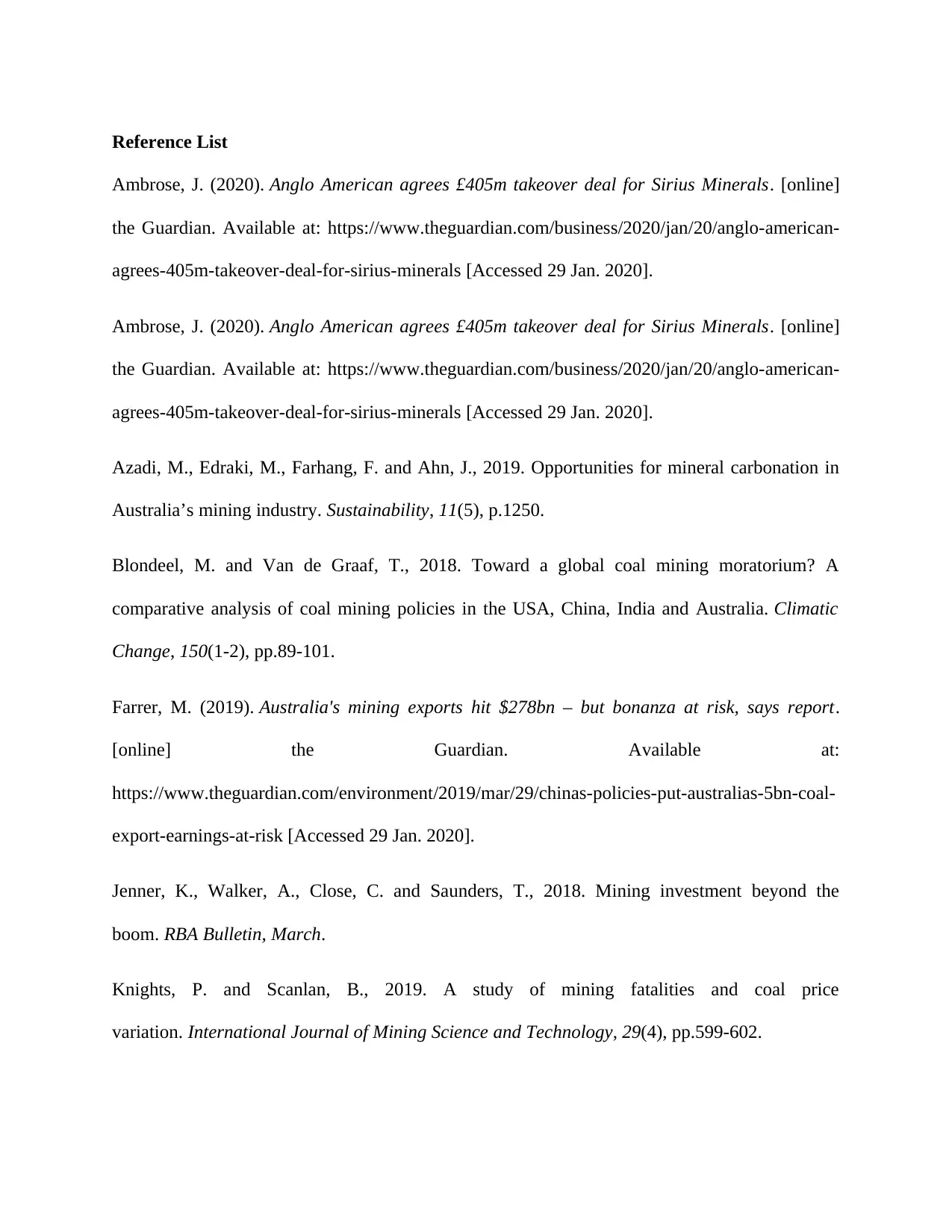
Reference List
Ambrose, J. (2020). Anglo American agrees £405m takeover deal for Sirius Minerals. [online]
the Guardian. Available at: https://www.theguardian.com/business/2020/jan/20/anglo-american-
agrees-405m-takeover-deal-for-sirius-minerals [Accessed 29 Jan. 2020].
Ambrose, J. (2020). Anglo American agrees £405m takeover deal for Sirius Minerals. [online]
the Guardian. Available at: https://www.theguardian.com/business/2020/jan/20/anglo-american-
agrees-405m-takeover-deal-for-sirius-minerals [Accessed 29 Jan. 2020].
Azadi, M., Edraki, M., Farhang, F. and Ahn, J., 2019. Opportunities for mineral carbonation in
Australia’s mining industry. Sustainability, 11(5), p.1250.
Blondeel, M. and Van de Graaf, T., 2018. Toward a global coal mining moratorium? A
comparative analysis of coal mining policies in the USA, China, India and Australia. Climatic
Change, 150(1-2), pp.89-101.
Farrer, M. (2019). Australia's mining exports hit $278bn – but bonanza at risk, says report.
[online] the Guardian. Available at:
https://www.theguardian.com/environment/2019/mar/29/chinas-policies-put-australias-5bn-coal-
export-earnings-at-risk [Accessed 29 Jan. 2020].
Jenner, K., Walker, A., Close, C. and Saunders, T., 2018. Mining investment beyond the
boom. RBA Bulletin, March.
Knights, P. and Scanlan, B., 2019. A study of mining fatalities and coal price
variation. International Journal of Mining Science and Technology, 29(4), pp.599-602.
Ambrose, J. (2020). Anglo American agrees £405m takeover deal for Sirius Minerals. [online]
the Guardian. Available at: https://www.theguardian.com/business/2020/jan/20/anglo-american-
agrees-405m-takeover-deal-for-sirius-minerals [Accessed 29 Jan. 2020].
Ambrose, J. (2020). Anglo American agrees £405m takeover deal for Sirius Minerals. [online]
the Guardian. Available at: https://www.theguardian.com/business/2020/jan/20/anglo-american-
agrees-405m-takeover-deal-for-sirius-minerals [Accessed 29 Jan. 2020].
Azadi, M., Edraki, M., Farhang, F. and Ahn, J., 2019. Opportunities for mineral carbonation in
Australia’s mining industry. Sustainability, 11(5), p.1250.
Blondeel, M. and Van de Graaf, T., 2018. Toward a global coal mining moratorium? A
comparative analysis of coal mining policies in the USA, China, India and Australia. Climatic
Change, 150(1-2), pp.89-101.
Farrer, M. (2019). Australia's mining exports hit $278bn – but bonanza at risk, says report.
[online] the Guardian. Available at:
https://www.theguardian.com/environment/2019/mar/29/chinas-policies-put-australias-5bn-coal-
export-earnings-at-risk [Accessed 29 Jan. 2020].
Jenner, K., Walker, A., Close, C. and Saunders, T., 2018. Mining investment beyond the
boom. RBA Bulletin, March.
Knights, P. and Scanlan, B., 2019. A study of mining fatalities and coal price
variation. International Journal of Mining Science and Technology, 29(4), pp.599-602.
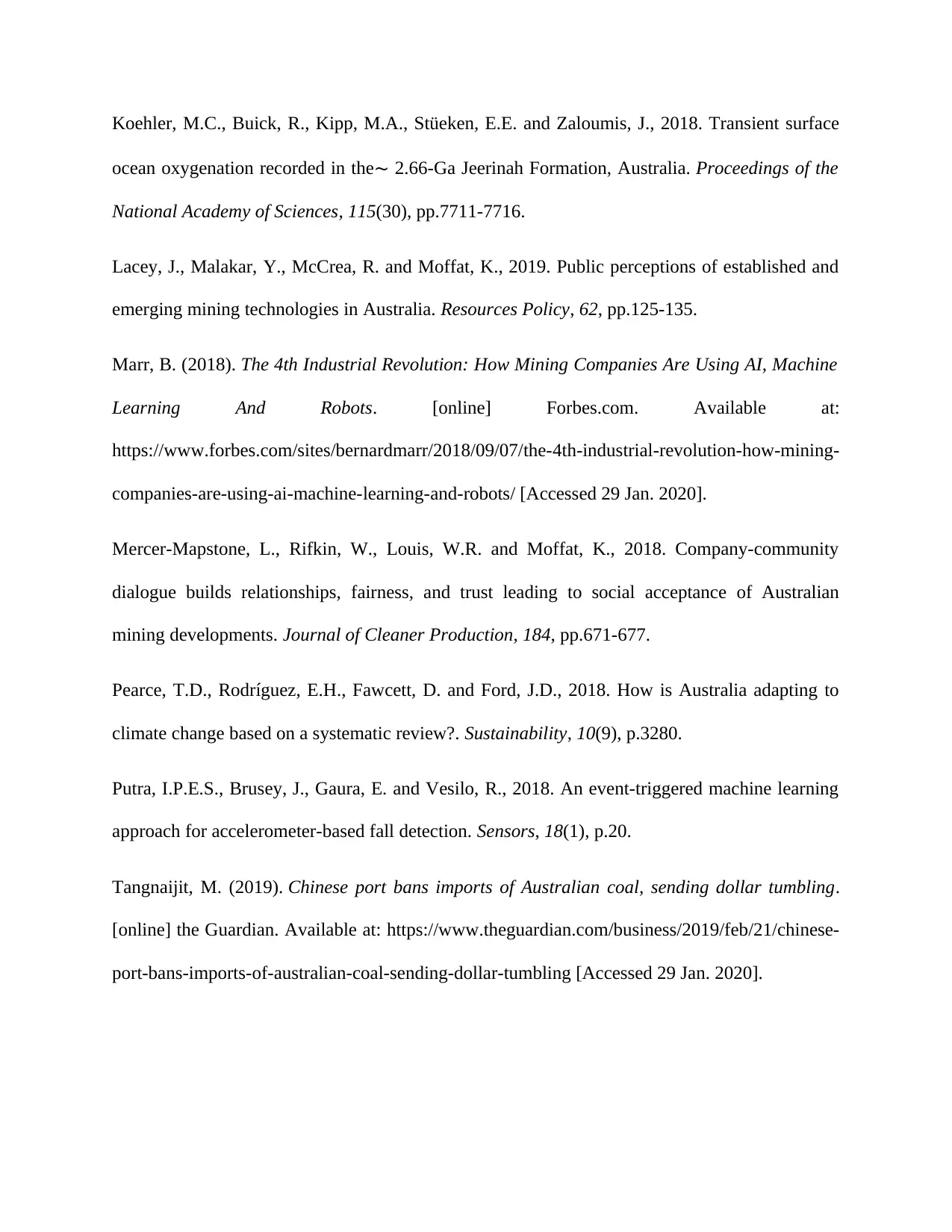
Koehler, M.C., Buick, R., Kipp, M.A., Stüeken, E.E. and Zaloumis, J., 2018. Transient surface
ocean oxygenation recorded in the∼ 2.66-Ga Jeerinah Formation, Australia. Proceedings of the
National Academy of Sciences, 115(30), pp.7711-7716.
Lacey, J., Malakar, Y., McCrea, R. and Moffat, K., 2019. Public perceptions of established and
emerging mining technologies in Australia. Resources Policy, 62, pp.125-135.
Marr, B. (2018). The 4th Industrial Revolution: How Mining Companies Are Using AI, Machine
Learning And Robots. [online] Forbes.com. Available at:
https://www.forbes.com/sites/bernardmarr/2018/09/07/the-4th-industrial-revolution-how-mining-
companies-are-using-ai-machine-learning-and-robots/ [Accessed 29 Jan. 2020].
Mercer-Mapstone, L., Rifkin, W., Louis, W.R. and Moffat, K., 2018. Company-community
dialogue builds relationships, fairness, and trust leading to social acceptance of Australian
mining developments. Journal of Cleaner Production, 184, pp.671-677.
Pearce, T.D., Rodríguez, E.H., Fawcett, D. and Ford, J.D., 2018. How is Australia adapting to
climate change based on a systematic review?. Sustainability, 10(9), p.3280.
Putra, I.P.E.S., Brusey, J., Gaura, E. and Vesilo, R., 2018. An event-triggered machine learning
approach for accelerometer-based fall detection. Sensors, 18(1), p.20.
Tangnaijit, M. (2019). Chinese port bans imports of Australian coal, sending dollar tumbling.
[online] the Guardian. Available at: https://www.theguardian.com/business/2019/feb/21/chinese-
port-bans-imports-of-australian-coal-sending-dollar-tumbling [Accessed 29 Jan. 2020].
ocean oxygenation recorded in the∼ 2.66-Ga Jeerinah Formation, Australia. Proceedings of the
National Academy of Sciences, 115(30), pp.7711-7716.
Lacey, J., Malakar, Y., McCrea, R. and Moffat, K., 2019. Public perceptions of established and
emerging mining technologies in Australia. Resources Policy, 62, pp.125-135.
Marr, B. (2018). The 4th Industrial Revolution: How Mining Companies Are Using AI, Machine
Learning And Robots. [online] Forbes.com. Available at:
https://www.forbes.com/sites/bernardmarr/2018/09/07/the-4th-industrial-revolution-how-mining-
companies-are-using-ai-machine-learning-and-robots/ [Accessed 29 Jan. 2020].
Mercer-Mapstone, L., Rifkin, W., Louis, W.R. and Moffat, K., 2018. Company-community
dialogue builds relationships, fairness, and trust leading to social acceptance of Australian
mining developments. Journal of Cleaner Production, 184, pp.671-677.
Pearce, T.D., Rodríguez, E.H., Fawcett, D. and Ford, J.D., 2018. How is Australia adapting to
climate change based on a systematic review?. Sustainability, 10(9), p.3280.
Putra, I.P.E.S., Brusey, J., Gaura, E. and Vesilo, R., 2018. An event-triggered machine learning
approach for accelerometer-based fall detection. Sensors, 18(1), p.20.
Tangnaijit, M. (2019). Chinese port bans imports of Australian coal, sending dollar tumbling.
[online] the Guardian. Available at: https://www.theguardian.com/business/2019/feb/21/chinese-
port-bans-imports-of-australian-coal-sending-dollar-tumbling [Accessed 29 Jan. 2020].
⊘ This is a preview!⊘
Do you want full access?
Subscribe today to unlock all pages.

Trusted by 1+ million students worldwide
1 out of 13
Related Documents
Your All-in-One AI-Powered Toolkit for Academic Success.
+13062052269
info@desklib.com
Available 24*7 on WhatsApp / Email
![[object Object]](/_next/static/media/star-bottom.7253800d.svg)
Unlock your academic potential
Copyright © 2020–2025 A2Z Services. All Rights Reserved. Developed and managed by ZUCOL.





